|

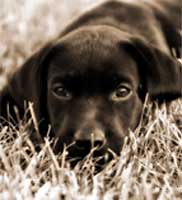 Paint by Numbers: Labradors are relatively large with males typically weighing 60 to 80 lb and females 45 to 70 lb. They are energetic, outgoing dogs. Their coats are short and smooth, and can be black, yellow, or brown (called "chocolate") in color, in that order of frequency. Puppies of all colors can potentially occur in the same litter. The color is determined primarily by two genes. Variations in numerous other genes control the subtler details of the coat's coloration, which in yellow labs varies from white to light gold to a fox red. Yellow labs can have black or pink noses; chocolate and black labs's noses match the coat color. A very light color sometimes called 'silver' is not officially recognized, but is sought by some owners and therefore unusually light colored yellow and chocolate labs may be described this way by unscrupulous breeders. Paint by Numbers: Labradors are relatively large with males typically weighing 60 to 80 lb and females 45 to 70 lb. They are energetic, outgoing dogs. Their coats are short and smooth, and can be black, yellow, or brown (called "chocolate") in color, in that order of frequency. Puppies of all colors can potentially occur in the same litter. The color is determined primarily by two genes. Variations in numerous other genes control the subtler details of the coat's coloration, which in yellow labs varies from white to light gold to a fox red. Yellow labs can have black or pink noses; chocolate and black labs's noses match the coat color. A very light color sometimes called 'silver' is not officially recognized, but is sought by some owners and therefore unusually light colored yellow and chocolate labs may be described this way by unscrupulous breeders.
Separated by a common language: As with some other breeds, the English and the American lines differ slightly. Labs are bred in England as a medium size dog, shorter and stockier with fuller faces than their American counterparts which are bred as a larger dog. No distinction is made by the AKC, but the two classifications come from different breeding. Australian stock also exists; though not seen in the west, they are common in Asia.
A Nice Cool Dip: The breed tends to shed hair regularly throughout the year. Lab hair is usually fairly short and straight, and the tail quite broad and strong. The otter-like tail and webbed toes of the Labrador Retriever make them excellent swimmers. Their interwoven coat is also relatively waterproof, providing more assistance for swimming. The tail acts as a rudder for changing directions. The dogs also have webbed front and back toes.
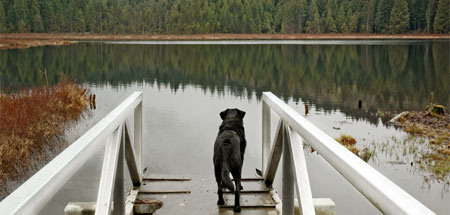
Similar Stock: Many people unfamiliar with retrievers find that the Lab is quite similar to the Golden Retriever in size, general shape, and general color, especially when young and especially to those Goldens with lighter coats. Their personalities are also quite similar, with both breeds being intelligent, friendly, receptive to praise and easy to train. The most obvious difference is the short straight coat of the Labrador Retriever (the Golden has long wavy fur) and the Lab's thick, otter-like tail compared to the Golden's plumed tail.

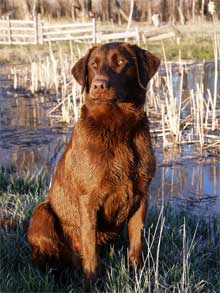 Child Prodigy: Labradors are a well-balanced and remarkably versatile breed, adaptable to a wide range of functions as well as making very good pets. They are easily trained and are a very obedient breed. They are loyal companions that share the love you give to them. They are very friendly dogs and are great with children. As a rule they are not excessively prone to territorialism, pining, insecurity, aggression, destructiveness, hypersensitivity, or other difficult traits which manifest in a variety of breeds, and as the name suggests, they are excellent retrievers.
As an extension of this, they instinctively enjoy holding objects and even hands or arms in their mouths, which they can do with great gentleness. They are, however, prone to chewing objects (though they can easily be trained out of this behavior). The Labrador Retriever's coat repels water to some extent, thus facilitating the extensive use of the dog in waterfowl hunting. Child Prodigy: Labradors are a well-balanced and remarkably versatile breed, adaptable to a wide range of functions as well as making very good pets. They are easily trained and are a very obedient breed. They are loyal companions that share the love you give to them. They are very friendly dogs and are great with children. As a rule they are not excessively prone to territorialism, pining, insecurity, aggression, destructiveness, hypersensitivity, or other difficult traits which manifest in a variety of breeds, and as the name suggests, they are excellent retrievers.
As an extension of this, they instinctively enjoy holding objects and even hands or arms in their mouths, which they can do with great gentleness. They are, however, prone to chewing objects (though they can easily be trained out of this behavior). The Labrador Retriever's coat repels water to some extent, thus facilitating the extensive use of the dog in waterfowl hunting.
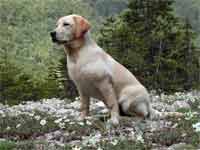 Run Doggy, Run!: Labradors have a reputation as a very
mellow breed and an excellent family dog (including a good reputation with children
of all ages), but some lines (particularly those that have continued to be bred specifically for their skills at working in the field rather than
for their appearance) are particularly fast and athletic. Their fun-loving boisterousness
and lack of fear can result in mischief, and may require training and firm handling at
times to ensure it does not get out of hand. Most Labs enjoy retrieving a ball endlessly and other forms of activity (such as dog agility or flyball), are considerably "food and fun" oriented, very trainable and open-minded to new things, and thrive on human attention and interaction, which they find hard to get enough of. Reflecting their retrieving bloodlines, almost every Lab loves playing in water or swimming. Run Doggy, Run!: Labradors have a reputation as a very
mellow breed and an excellent family dog (including a good reputation with children
of all ages), but some lines (particularly those that have continued to be bred specifically for their skills at working in the field rather than
for their appearance) are particularly fast and athletic. Their fun-loving boisterousness
and lack of fear can result in mischief, and may require training and firm handling at
times to ensure it does not get out of hand. Most Labs enjoy retrieving a ball endlessly and other forms of activity (such as dog agility or flyball), are considerably "food and fun" oriented, very trainable and open-minded to new things, and thrive on human attention and interaction, which they find hard to get enough of. Reflecting their retrieving bloodlines, almost every Lab loves playing in water or swimming.
Eat, Drink, and be Merry: Many Labs are notorious "chowhounds"; they will eat anything that isn't nailed down, and are experts at manipulating soft-hearted humans into giving them treats/extra food/table scraps/etc (Lab owners consider their pets masters of 'seal puppy' eyes). The Lab owner must carefully control his/her dog's food intake to avoid obesity and its associated health problems.
The steady temperament of Labs and their ability to learn quickly make them an ideal breed for assistance dogs.
Health Watch :
Some lines of Labs are fast and athletic. Labrador life expectancy is generally 12 to 13 years, and it is a healthy breed with relatively few major problems. Common Lab health issues are:
* Labs are somewhat prone to hip dysplasia, especially the larger dogs, though not as much as some other breeds. Hip scores are recommended before breeding.
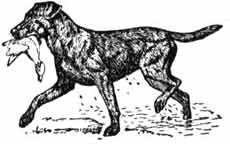 * Labs are sometimes prone to ear infection, because their floppy ears trap warm moist air. This is easy to control, but needs regular checking to ensure that a problem is not building up unseen. A healthy Lab ear should look clean and light pink (almost white) inside. Darker pink (or inflamed red), or brownish deposits, are a symptom of ear infection. The usual treatment is regular cleaning daily or twice daily (being careful not to force dirt into the sensitive inner ear) and sometimes medication (ear drops) for major cases. As a preventative measure, some owners clip the hair carefully around the ear and under the flap, to encourage better air flow. * Labs are sometimes prone to ear infection, because their floppy ears trap warm moist air. This is easy to control, but needs regular checking to ensure that a problem is not building up unseen. A healthy Lab ear should look clean and light pink (almost white) inside. Darker pink (or inflamed red), or brownish deposits, are a symptom of ear infection. The usual treatment is regular cleaning daily or twice daily (being careful not to force dirt into the sensitive inner ear) and sometimes medication (ear drops) for major cases. As a preventative measure, some owners clip the hair carefully around the ear and under the flap, to encourage better air flow.
* Labs are often overfed and are allowed to become overweight, due to their blatant enjoyment of treats, hearty appetites, and endearing behavior towards people. A healthy Lab should keep a very slight hourglass waist and be fit and lithe, rather than fat or heavy-set. Excessive weight is strongly implicated as a risk factor in the later development of hip dysplasia and diabetes, and also can contribute to general reduced health when older. Arthritis is commonplace in older, overweight labs.
* A Labrador that undertakes significant swimming without building up can develop a swelling or apparent kink known as swimtail. This can be easily treated by a veterinary clinic and tail rest.
* Many times Labs also suffer from the risk of knee problems. A luxating patella is a common occurrence in the knee where the leg is often bow shaped.
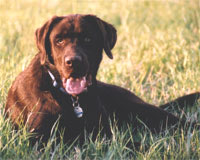 Puppy mills and dog theft: Because the Labrador is such a popular breed, they are often reared in puppy mills where the people responsible care primarily for profit, and not for the dog's well being. Labs and Lab owners also commonly fall victim to dog theft, where any purebred-looking Labradors may be sold to puppy mills or unknowing prospective owners for a high profit to the thief. Microchipping for Labradors—as for any dog—increases the possibility of finding lost Puppy mills and dog theft: Because the Labrador is such a popular breed, they are often reared in puppy mills where the people responsible care primarily for profit, and not for the dog's well being. Labs and Lab owners also commonly fall victim to dog theft, where any purebred-looking Labradors may be sold to puppy mills or unknowing prospective owners for a high profit to the thief. Microchipping for Labradors—as for any dog—increases the possibility of finding lost
or stolen dogs, because the microchip cannot be easily removed like a collar and
dog tags.
Labrador variants:
* Although kennel clubs and registries recognize the Labrador in variations of only three colors—black, yellow, and chocolate—some breeders sell light-colored yellow Labrador puppies as a "white" labrador, the dark yellow Labrador puppies as "fox red," or chocolates possessing the dilution factor as "silver Labradors". The "silver" color is nonstandard and would disqualify them as show dogs. However, the "fox red" and so-called "white" labs (more properly referred to as "cream" by the AKC) are perfectly acceptable shades for a Yellow lab in the show ring. The dog's color does not affect its behavior or health and many people own "silver" labs as companion dogs.
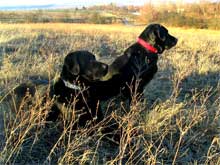 * Black labs have dominated the field trial and hunt test scene (Fergus, 2002). Because the lighter variants are a recessive trait, breeding for a litter of yellow or chocolate pups requires mating two dogs with those traits. This means that dogs from these litters were selected for traits other than nose, biddability, intelligence, and hunting desire (Fergus, 2002). Because even a pairing of black labs may produce chocolate or yellow offspring, this rule does not hold 100% of the time. Even so, many serious field trialers and hunters prefer black labradors over the other variants to increase the odds of solid hunting genes (Fergus, 2002). * Black labs have dominated the field trial and hunt test scene (Fergus, 2002). Because the lighter variants are a recessive trait, breeding for a litter of yellow or chocolate pups requires mating two dogs with those traits. This means that dogs from these litters were selected for traits other than nose, biddability, intelligence, and hunting desire (Fergus, 2002). Because even a pairing of black labs may produce chocolate or yellow offspring, this rule does not hold 100% of the time. Even so, many serious field trialers and hunters prefer black labradors over the other variants to increase the odds of solid hunting genes (Fergus, 2002).
* In addition to color variations, differences in the physical build of the dog have arisen as a result of specialized breeding. Distinct lines are bred for specific purposes. Dogs bred for field trials tend to be lighter in limb and often lack the very large, square head, shorter legs, and heavier bodies seen in the show ring. Differences tend to occur as dogs bred for hunting and field-trial work are selected first for working ability, whereas dogs bred to compete for show championships are selected for what judges look for in the show ring. In fact, breeders and owners sometimes distinguish the "working" Labrador from the "show" Labrador, given the marked differences in their physical characteristics. The majority of dogs bred are generally some where between what is displayed in the "show" Labrador and what is seen in the "working" Labrador.
* The Labradoodle is a common mixed-breed dog that combines a Labrador with a Poodle. These dogs are popular for their hypoallergenic qualities.
* Labrador-German Shepherd and Labrador-Border Collie crosses are also rather popular, at least for their intelligence and working qualities.

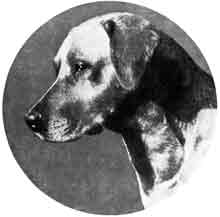 A Brave New World: The Labrador is believed to have originated on the island of Newfoundland, now part
of the province of Newfoundland and Labrador, Canada. It is thought to have descended from the St. John's Water
Dog (no longer in existence), a
crossbreed of native water dogs A Brave New World: The Labrador is believed to have originated on the island of Newfoundland, now part
of the province of Newfoundland and Labrador, Canada. It is thought to have descended from the St. John's Water
Dog (no longer in existence), a
crossbreed of native water dogs
and
the Newfoundland to which the Labradoris closely related. The name Labrador was given to this dog by the
Earl of Malmesbury and other breeders in England in order to differentiate them from the Newfoundland dog. The Labrador Retriever was originally called the lesser Newfoundland or the St. John's dog. Other origins suggested for the name include the Spanish or Portuguese word for workers, labradores, and the village of Castro Laboreiro in Portugal whose herding and guard dogs bear a "striking resemblance" to Labradors.
Many fishermen originally used the Lab to assist in bringing nets to shore; the dog would grab the floating corks on the ends of the nets and pull them to shore.
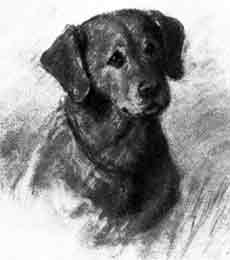 Sportsman of the Year: The first known written reference to the Labrador is in 1814 in "Instructions to Young Sportsmen". In 1823 sporting artist Edwin Landseer painted a black dog with white markings titled Cora. A Labrador Bitch, by which time it appears the breed was already firmly established, with several of the nobility either owning or breeding them by the end of that century. The first Yellow Lab on record, named Ben of Hyde, was born in 1899. Sportsman of the Year: The first known written reference to the Labrador is in 1814 in "Instructions to Young Sportsmen". In 1823 sporting artist Edwin Landseer painted a black dog with white markings titled Cora. A Labrador Bitch, by which time it appears the breed was already firmly established, with several of the nobility either owning or breeding them by the end of that century. The first Yellow Lab on record, named Ben of Hyde, was born in 1899.
The modern Labrador Retriever is among the oldest of the modern "recognized" breeds; according to the American Kennel Club, pedigrees exist back to 1878. The Kennel Club recognized the Lab in 1903. The first registration of Labradors by the AKC was in 1917; many English dogs were imported post World War I and these formed the foundation of the American variety.
All text is available under the terms
of the GNU Free Documentation License
|
